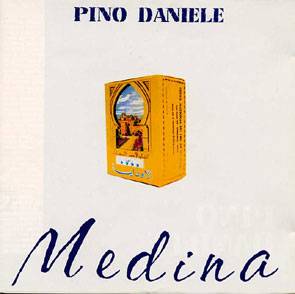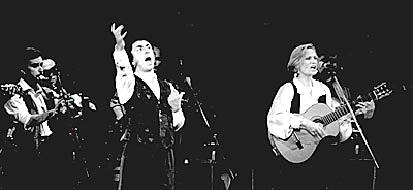The persistence of the idea that nothing new could be
done to the Neapolitan song is demonstrated by the
clearly articulated position towards it taken by those
Neapolitan musicians who have obtained recent national
success. These successes took place after an eclipse that
lasted at least a decade, during which the only pop hits
of Neapolitan inspiration were those - largely
Americanized in their sound and adapted to the vocal
style and musical logic of the singer-songwriter - by
Peppino di Capri. The so-called 'Neapolitan school'
advertised by record companies at the beginning of the
Seventies was formed by musicians for whom references to
jazz and soul music were stronger than any regional
reference, despite the use of their dialect:
southern-ness consisted of a metonymic play with
blackness.
In the first half of the 1970s, the Nuova
Compagnia di Canto Popolare affirmed itself
nationwide, proceeding to recover, decidedly and
explicitly, the repertoires, instruments and expressive
methods of the Neapolitan tradition although –
according to some – their efforts were mostly
focused on written sources.
It was no coincidence that new groups that privileged the relationship with the still living or revitalized oral tradition, such as the Gruppo Operaio E’ Zezi di Pomigliano d’Arco, were soon opposed to them.
Both were cases of work of great quality whose nationwide success is particularly significant: nonetheless, one must note how the repertoire of Neapolitan song was again considered as an ‘other’ to whom one could be compared, in a manner reminiscent of the urban popular vs. peasant dialectics of Bartòkian origin. The period between 1964 (the year of the scandal-causing presence of the Nuovo Canzoniere Italiano at the Spoleto Festival) and 1978 (the year of the assassination of Aldo Moro and the end of the political movement known as ‘il Sessantotto’, or ‘Sixty-eight’) is characterized by the strong presence of popular music, and the recovery of the oral tradition on the musical scene and in the conscience of Italian musicians, even of those committed to song and popular music. At times the revival took on commercial connotations that disturbed its scholars and most serious practitioners, such as when ‘folk music’ ended up being performed on the TV program, Canzonissima, the epitome of television consumerism. What is of interest is that in those years a great deal of popular music circulated in Italy. Singer-songwriter and rock groups declared that they wanted to escape American influences in order to be inspired by the ‘authentic roots’ of Italian song. Since the Istituto De Martino was at the height of its activity – there was no difficulty in learning its sources, from the Genoese trallallero and Sardinian choirs to the dances of the tarantolati, to quote but a few of the musics unequivocally Mediterranean on the basis of their geographic location. Italy is a country that stretches into the center of the Mediterranean, whose repertoire of songs in dialect has been identified worldwide with the sun and the sea of Naples (and Venice, and all of Italy), and had a recently rediscovered heritage of oral tradition. One could reasonably have predicted that a search for authenticity (if the meaning of the word is what it seems to be) in musica leggera, or in Italian popular music, would take place through a relationship with these repertoires and traditions. |


